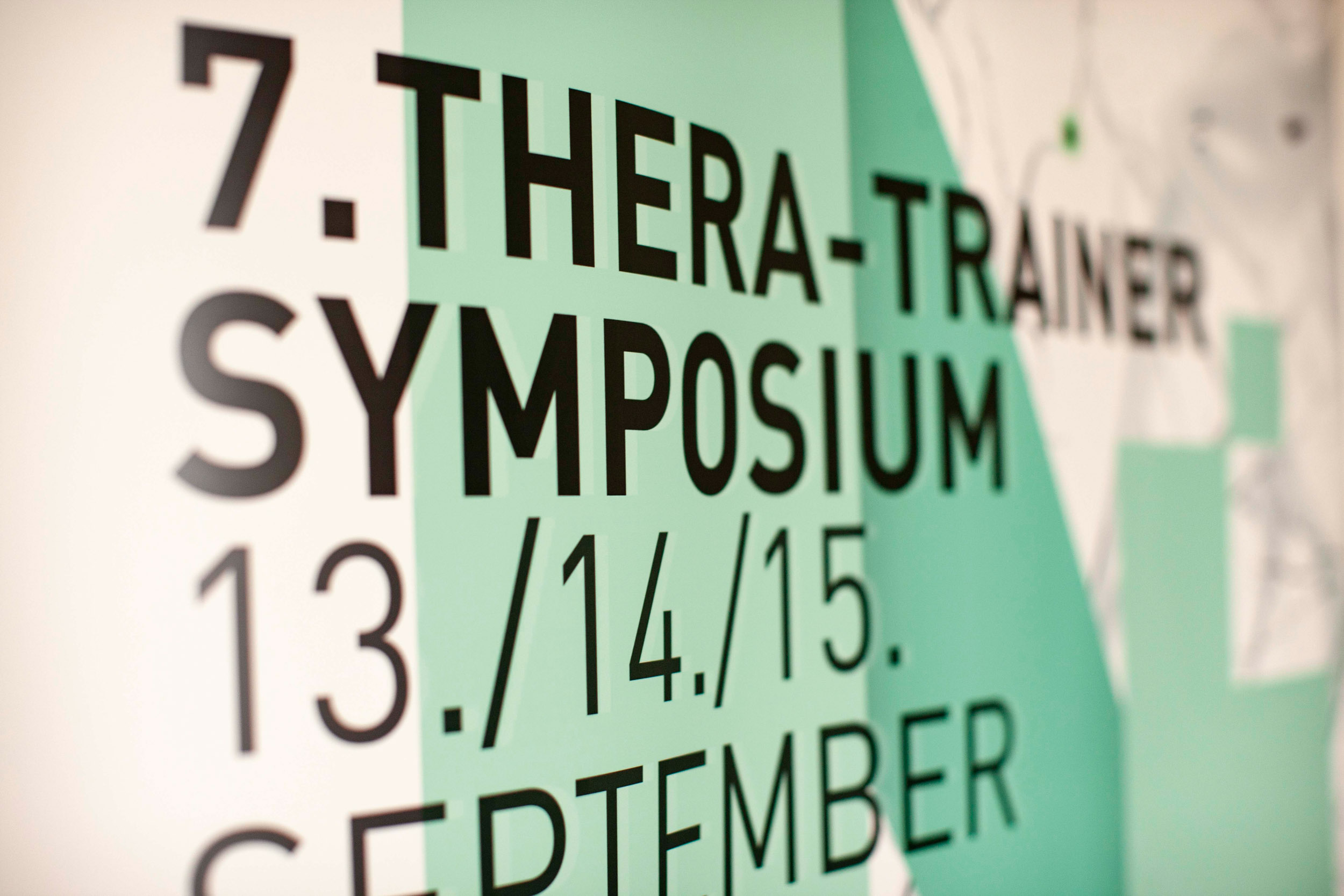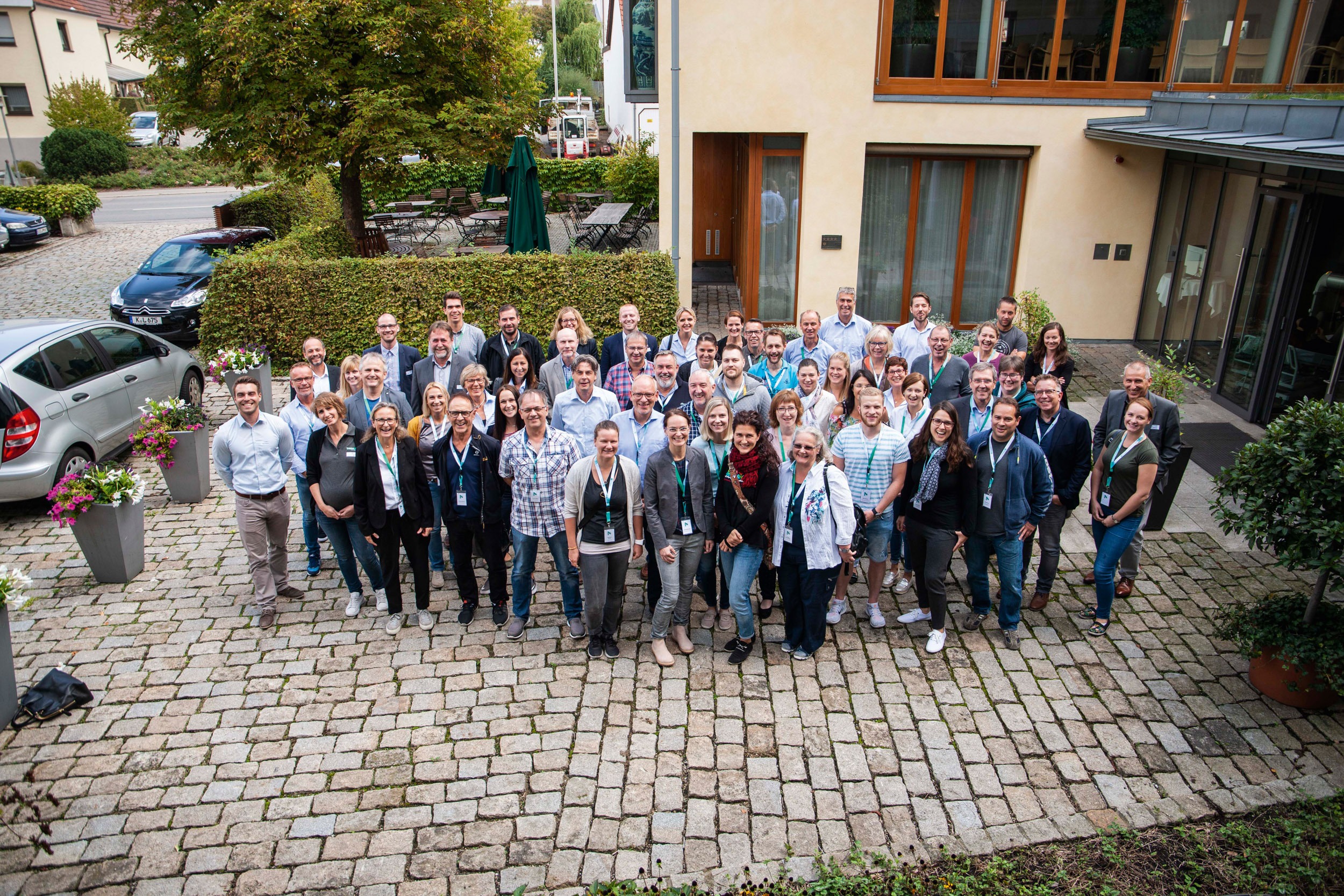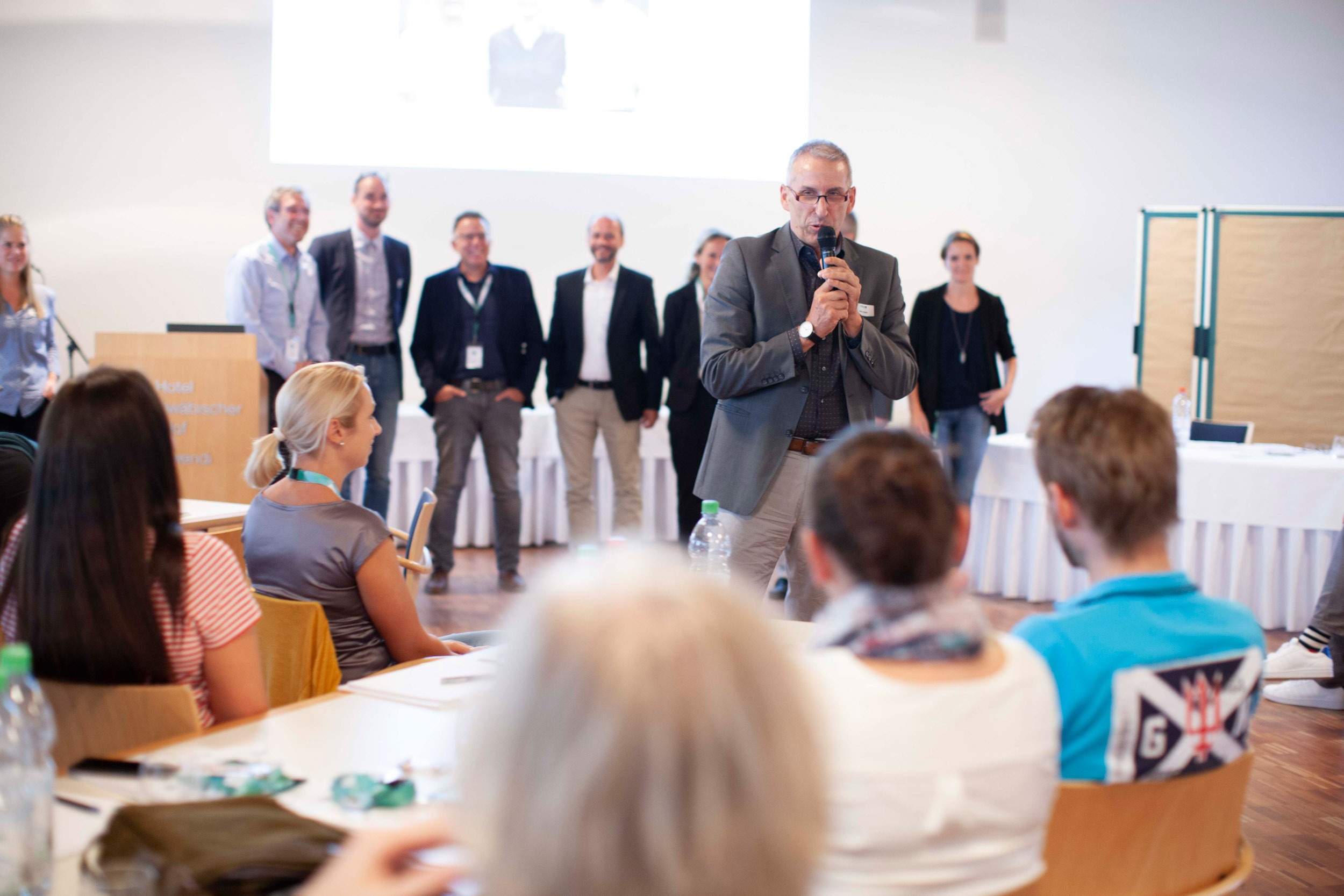
THERAPY-Magazin
Rethinking rehabilitation

Melanie Grom
Public Relations Manager at THERA-Trainer
The 7th THERA-Trainer Symposium in September 2018 offered visitors an attractive programme, inviting them to reflect and rethink. Through its high-profile lectures, workshops and discussions, participants were updated on neurorehabilitation.
The framework conditions in neurological rehabilitation have been changing for years, and the industry is constantly on the move. While the number of patients requiring treatment is growing, the framework conditions in everyday clinical practice are becoming increasingly difficult: shortage of skilled labour, cost pressures and new scientific findings present major challenges.
Against this background, the symposium brought together therapists, experts and innovators in neurorehabilitation. Exciting new ideas and concepts from well-known speakers and innovators formed the basis for intensive dialogue and constructive exchange. The main topics of the event, under the scientific direction of the two physiotherapists and neurorehabilitation experts Sabine Lamprecht and Martin Huber, were the (new) requirements in neurorehabilitation, particularly in gait rehabilitation. The latest research results and guidelines need to be combined with proven therapeutic procedures and implemented in best practice therapies in day-to-day clinical practice.
Dr. Werner Nickels, Head of Neurology at the SRH Health Centre Dobel, and Helmut Krause, Managing Director of AMBUTHERA, addressed the conflict between the requirements and the reality of evidence-based neurorehabilitation, as well as the possibilities for establishing new clinical treatment pathways and ensuring their quality. According to Nickels, radical optimisations in terms of effectiveness, efficiency, transparency and cost-effectiveness are necessary to keep treatment costs within reasonable limits. Although – or perhaps because – many patients still insist on a hands-on therapy and consider it better, the chief physician developed a novel concept in his clinic: in a new type of group training, his patients receive individualised therapies, resulting in a much higher treatment density. The reorganisation has enabled patients to receive between 50 and 60% more therapy, which equates to around two additional hours per day; Phase C patients receive up to 80% more therapy. A group does not always have to be “equal to 10 people” – even two or three patients could be grouped together.
New clinical treatment pathways must not only be established, but their quality must also be ensured, says Krause. Due to the multi-professional nature of neurorehabilitation, changing established structural and conceptual notions of therapy is a challenge. Nickels and Krause, and later also Gunter Hölig, agree that successful practical implementation of new therapeutic methods is always dependent on the openness of the therapist to new concepts, but that the employees must also be brought on board as these are introduced. But the patient must similarly be “engaged”, by boosting his self-confidence and his motivation via a process of education. To that end, it is necessary to formulate therapeutic goals to be as close to everyday life as possible and, above all, to give quantitative feedback.
In a research project, Zurich’s RehaZentrum Wald is investigating the effectiveness of gait trainer therapy in stroke rehabilitation compared to conventional physiotherapy under conditions as close as possible to everyday life. A conventional treatment comprising five individual therapies per week is compared with the combination of three individual therapies plus two sessions with the THERA-Trainer lyra gait trainer per week. As yet, no clear trends are detectable.
Gunter Hölig, head of therapy at the Medical Park Bad Rodach, started by addressing movement, as the overarching theme of the event: Only after a short, active loosening-up programme did he begin his lecture about requirements and strategies for efficient in-patient treatment of stroke patients. In his opinion, it is indisputable that a physiotherapy treatment in combination with robotics is better than physiotherapy alone. In addition, he says, it is quite possible for a therapist to take care of four patients during a therapy session, with the help of device training. However, the concrete implementation and scheduling of these methods in the treatment path is also frequently unclear, in his view.
Against this background, the symposium brought together therapists, experts and innovators in neurorehabilitation. Exciting new ideas and concepts from well-known speakers and innovators formed the basis for intensive dialogue and constructive exchange. The main topics of the event, under the scientific direction of the two physiotherapists and neurorehabilitation experts Sabine Lamprecht and Martin Huber, were the (new) requirements in neurorehabilitation, particularly in gait rehabilitation. The latest research results and guidelines need to be combined with proven therapeutic procedures and implemented in best practice therapies in day-to-day clinical practice.
Dr. Werner Nickels, Head of Neurology at the SRH Health Centre Dobel, and Helmut Krause, Managing Director of AMBUTHERA, addressed the conflict between the requirements and the reality of evidence-based neurorehabilitation, as well as the possibilities for establishing new clinical treatment pathways and ensuring their quality. According to Nickels, radical optimisations in terms of effectiveness, efficiency, transparency and cost-effectiveness are necessary to keep treatment costs within reasonable limits. Although – or perhaps because – many patients still insist on a hands-on therapy and consider it better, the chief physician developed a novel concept in his clinic: in a new type of group training, his patients receive individualised therapies, resulting in a much higher treatment density. The reorganisation has enabled patients to receive between 50 and 60% more therapy, which equates to around two additional hours per day; Phase C patients receive up to 80% more therapy. A group does not always have to be “equal to 10 people” – even two or three patients could be grouped together.
New clinical treatment pathways must not only be established, but their quality must also be ensured, says Krause. Due to the multi-professional nature of neurorehabilitation, changing established structural and conceptual notions of therapy is a challenge. Nickels and Krause, and later also Gunter Hölig, agree that successful practical implementation of new therapeutic methods is always dependent on the openness of the therapist to new concepts, but that the employees must also be brought on board as these are introduced. But the patient must similarly be “engaged”, by boosting his self-confidence and his motivation via a process of education. To that end, it is necessary to formulate therapeutic goals to be as close to everyday life as possible and, above all, to give quantitative feedback.
In a research project, Zurich’s RehaZentrum Wald is investigating the effectiveness of gait trainer therapy in stroke rehabilitation compared to conventional physiotherapy under conditions as close as possible to everyday life. A conventional treatment comprising five individual therapies per week is compared with the combination of three individual therapies plus two sessions with the THERA-Trainer lyra gait trainer per week. As yet, no clear trends are detectable.
Gunter Hölig, head of therapy at the Medical Park Bad Rodach, started by addressing movement, as the overarching theme of the event: Only after a short, active loosening-up programme did he begin his lecture about requirements and strategies for efficient in-patient treatment of stroke patients. In his opinion, it is indisputable that a physiotherapy treatment in combination with robotics is better than physiotherapy alone. In addition, he says, it is quite possible for a therapist to take care of four patients during a therapy session, with the help of device training. However, the concrete implementation and scheduling of these methods in the treatment path is also frequently unclear, in his view.

The more you know about the brain, the more you realize how much you don’t know.
Medica Product Manager Jakob Tiebel took as his subject the wide gap between practice and research: He stated that there is a great deal of research and it has now been proven that active-practise procedures are superior to traditional treatments, above all due to the higher intensity of exercise. However, only 2% of the relevant studies deal with the implications for the daily routine of treatment. Environments needed to be created that make it possible to satisfy demands from studies or the ReMoS Guideline. There was intensive discussion amongst participants of the question: What does evidence mean, and how is science translated into practice? The type and scope of studies, together with the inclusion criteria used to select patients, were also critically considered. Ultimately, in the practice, patients could not be excluded from therapy, even by applying certain criteria. “We have to treat all patients, whether they meet any criteria or not,” said one of the therapists at the event. She is convinced that this situation creates a “natural defensive attitude” towards new concepts and studies, if a large number of patients at the practice cannot be included in a new therapy.
Health economist Ann-Kathrin Miller also provoked discussions with her lecture. When is it sensible to use the THERA-Trainer Complete Solution or another form of therapy? And how can this be defined? A clear distinction is difficult, because a therapy or its results always comprise several aspects. For example, it is not just walking ability that can be improved using a gait trainer. Other positive effects are also possible: improved quality of life, making it possible to (re-)experience walking itself, or training movement and motor skills. Miller also demonstrated that device-based circuit training can ensure better compliance with ReMoS guidelines and improve the outcome and quality of individual therapy.
Anne Boese, head of occupational therapy at Aatalklinik Wünnenberg, has similarly been very successful in implementing study results in practice. Similarly operating against the background where therapy for acquired brain damage is often not feasible with the scientifically recommended intensities in day-to-day working life, together with colleagues and the medical director, Dr. Buschfort, she developed a gait lab that consists of various therapy devices. Through accurate evaluation of patients and taking into account their (own!) therapy goal, an algorithm specifies the training in the gait lab and creates an individual training plan for each patient. As a result, the intensity of therapy can be increased by up to 250%, saving on resources.
Martin Huber looked at models for practical and effective motor learning. He is convinced that “active is better than passive” and “success is the basis for even more success.” He draws on studies that prove the importance of taking responsibility, autonomy, motivation and variety for motor learning and therapeutic success. For him, learning means achieving lasting change. The THERA-Trainer Complete Solution, for instance, offers excellent scope for training motor learning and self-efficacy.
Sabine Lamprecht, who owns her own neurological practice, concluded the lecture series. In closing, she forged the link to outpatient treatment. Her assessment was a sobering one: “Really good neurological practices are very rare. Most do things too late, too little and wrong.” A high-dose combination of conventional and technology-assisted therapies is more effective than standard care, she believes. This is because treatment results show that even years after the brain has been damaged, significant improvements can be achieved if the type and dose of therapy are right. However, she adds, many outpatient neurological practices are not well-equipped and barely work with devices, but almost only manually. Some patients in neurorehabilitation are given Parkinson’s-specific training, for example, and then find themselves in the outpatient clinic, on the massage bench. She sees one of the main reasons for this situation in the training of young physiotherapists, which is carried out using outdated standards and not state-of-the-art. Many newly-trained physiotherapists would therefore not know the current guidelines at all.
While the first day of the event provided a lot of input and discussion, on the second day participants had the opportunity to contribute their own opinions and experiences and play an active part in proceedings. In a workshop led by medica managing director Otto Höbel and product manager Ann-Kathrin Miller, there was the opportunity to engage with the product development process and to introduce needs from the customer’s point of view. Additionally, participants had the option to discuss change management and process changes in connection with device-based circuit training, or to test out various training devices.
In addition to networking and professional exchanges, the culinary arts were not neglected. After the programme had ended, the latest topics were discussed in a relaxed atmosphere during the evening program, with new contacts being made.
Health economist Ann-Kathrin Miller also provoked discussions with her lecture. When is it sensible to use the THERA-Trainer Complete Solution or another form of therapy? And how can this be defined? A clear distinction is difficult, because a therapy or its results always comprise several aspects. For example, it is not just walking ability that can be improved using a gait trainer. Other positive effects are also possible: improved quality of life, making it possible to (re-)experience walking itself, or training movement and motor skills. Miller also demonstrated that device-based circuit training can ensure better compliance with ReMoS guidelines and improve the outcome and quality of individual therapy.
Anne Boese, head of occupational therapy at Aatalklinik Wünnenberg, has similarly been very successful in implementing study results in practice. Similarly operating against the background where therapy for acquired brain damage is often not feasible with the scientifically recommended intensities in day-to-day working life, together with colleagues and the medical director, Dr. Buschfort, she developed a gait lab that consists of various therapy devices. Through accurate evaluation of patients and taking into account their (own!) therapy goal, an algorithm specifies the training in the gait lab and creates an individual training plan for each patient. As a result, the intensity of therapy can be increased by up to 250%, saving on resources.
Martin Huber looked at models for practical and effective motor learning. He is convinced that “active is better than passive” and “success is the basis for even more success.” He draws on studies that prove the importance of taking responsibility, autonomy, motivation and variety for motor learning and therapeutic success. For him, learning means achieving lasting change. The THERA-Trainer Complete Solution, for instance, offers excellent scope for training motor learning and self-efficacy.
Sabine Lamprecht, who owns her own neurological practice, concluded the lecture series. In closing, she forged the link to outpatient treatment. Her assessment was a sobering one: “Really good neurological practices are very rare. Most do things too late, too little and wrong.” A high-dose combination of conventional and technology-assisted therapies is more effective than standard care, she believes. This is because treatment results show that even years after the brain has been damaged, significant improvements can be achieved if the type and dose of therapy are right. However, she adds, many outpatient neurological practices are not well-equipped and barely work with devices, but almost only manually. Some patients in neurorehabilitation are given Parkinson’s-specific training, for example, and then find themselves in the outpatient clinic, on the massage bench. She sees one of the main reasons for this situation in the training of young physiotherapists, which is carried out using outdated standards and not state-of-the-art. Many newly-trained physiotherapists would therefore not know the current guidelines at all.
While the first day of the event provided a lot of input and discussion, on the second day participants had the opportunity to contribute their own opinions and experiences and play an active part in proceedings. In a workshop led by medica managing director Otto Höbel and product manager Ann-Kathrin Miller, there was the opportunity to engage with the product development process and to introduce needs from the customer’s point of view. Additionally, participants had the option to discuss change management and process changes in connection with device-based circuit training, or to test out various training devices.
In addition to networking and professional exchanges, the culinary arts were not neglected. After the programme had ended, the latest topics were discussed in a relaxed atmosphere during the evening program, with new contacts being made.

Fachkreise
Therapy & Practice
THERAPY 2019-I
THERAPY Magazine

Melanie Grom
Public Relations Manager at THERA-Trainer
Melanie Grom worked in public relations at THERA-Trainer. She focused on sharing information and insights about the introduction of equipment-based circuit training in neurological rehabilitation in Germany, contributing to the establishment of innovative therapeutic approaches.
References:
Related contents
Find related exciting contents in our media library.
This is not what you are searching for? Knowledge
Meet our specialists.
Are you interested in our solutions? Schedule a meeting with a Consultant to talk through your strategy and understand how TEHRA-Trainer can help you to advance rehabilitation.
You need to load content from reCAPTCHA to submit the form. Please note that doing so will share data with third-party providers.
More InformationYou are currently viewing a placeholder content from Turnstile. To access the actual content, click the button below. Please note that doing so will share data with third-party providers.
More Information